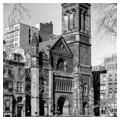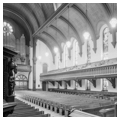The chief landmark of the square and one that attested to its social status is the fashionable brownstone Episcopal church whose square tower dominated the skyline until twentieth-century high-rises overwhelmed it. Designed in what was termed the Norman style, doubtless a reference to its round-headed arches and broad proportions, it takes the form of a broad hall-like church that served one of the first of the city's celebrity ministers, Phillips Brooks. Notman's original scheme called for an 80-foot tower surmounted by a 140-foot spire, not unlike the tower of his earlier and nearby St. Mark's (
PH78). Fortunately, the construction of the tower was delayed to the period when Philips Brooks was rector; he successfully fought for the shorter tower, without a spire, that was constructed in 1868 by George W. Hewitt, who had trained with Notman. The great preaching hall, a columnfree space capped by a trilobed roof and
The Hewitt brothers added the parish offices to the rear on Walnut Street (1891) as well as the long-demolished but architecturally splendid parish school with its high roof and yellow brick walls trimmed with brownstone that once extended to 20th Street. The choir robing room on the south side is the work of Cope and Stewardson (1897). The congregation commissioned a chapel of ease (Holy Trinity Chapel; PH93) to the west as Rittenhouse expanded.


















